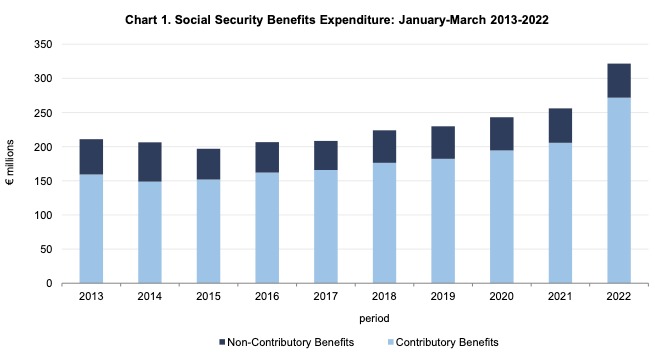Malta’s total expenditure on social security climbed to €322 million in the first quarter of this year, according to data released on Thursday by the National Statistics Office (NSO).
This was an increase of €256 million compared to the the same period of last year, representing a dramatic increase of 25.7 per cent.

Old age benefits (pensions) represented the lion’s share of this spending, at 82.4 per cent of all contributed benefits, with retirement spending increasing by €57.3 million as a result of two regular two-thirds pension payments made in March 2022.
Further increases were also registered under Contributory Bonus (€6.2 million), pensions in respect of widowhood (€2.5 million) and other benefits (€0.2 million).
Between January and March 2022, €50.2 million went towards Non-Contributory Benefits, a 0.5 per cent decrease in comparison to the previous year.
Children’s Allowance reported the highest number of Non-Contributory recipients, with 41,471 families in receipt of the benefit.
The increase is particularly notable considering the broader economic climate with Government debt having reached concerning heights, a spiralling cost of living crisis, and political promises to counter the impact of rising energy costs.
Firstly, Malta’s deficit hit €1.24 billion by the end of 2021, representing around 8.5 per cent of the country’s overall annual gross domestic product.
Last week, the Central Bank of Malta (CBM) projected that Malta will remain in deficit until 2024, while NSO data showed that by the end of March 2022, the Government’s debt stood at €8.47 billion, a €1.17 billion rise from the same time last year. Projections also indicate that Malta’s GDP will grow by six per cent in 2022 as economic recovery continues.
This figures place the Government, trying to shepherd a decimated economy out of the pandemic in something of a difficult position, forced to choose between subsidising businesses and individuals and further building deficit, or cutting expenditure to drive it down.
This is made all the more trying considering the cost of living crisis which is impacting most European countries, with existing COVID-related price hikes being compounded by Russia’s invasion of Ukraine.
Price increases of this type are usually expected to hit the most vulnerable in society (including pensioners) hardest, but the Government has shown a willingness to prop up vulnerable people and sectors.
For example, Finance Minister Clyde Caruana has defended the Government’s decision to limit energy price increases, stating that should prices increase, it would threaten to reverse the economic progress made since the pandemic began to ebb.
The approach to limiting energy price increases appears to have reaped rewards, and is largely credited with restraining overall inflation in the country, which recorded the lowest inflation rate across Europe in March, although concerns remain about the country’s longer-term economic outlook.
Indeed, Malta is facing a ‘high risk’ to its mid to long term financial sustainability, according to a Fiscal Sustainability Report for 2021 published by the European Commission. Published last week, the report cited a depletion of the Government’s budgetary position due to increased spending throughout the pandemic.
It called for a rein in on public spending, a sentiment also expressed by CBM governor Edward Scicluna.
Cautious optimism across sectors: Business confidence rebounds in Q1 2025, says Central Bank
Confidence is creeping back into Malta’s business community
Government unveils new framework to establish ‘national one-stop-shop for startups’
Emerging companies will be able to access the necessary support, such as an enhanced share awards and stock option scheme
Aviation leaders warn EU and local policies are jeopardising Malta connectivity
An event hosted by the MBN in collaboration with the IBN explored the challenges facing the tourism industry






